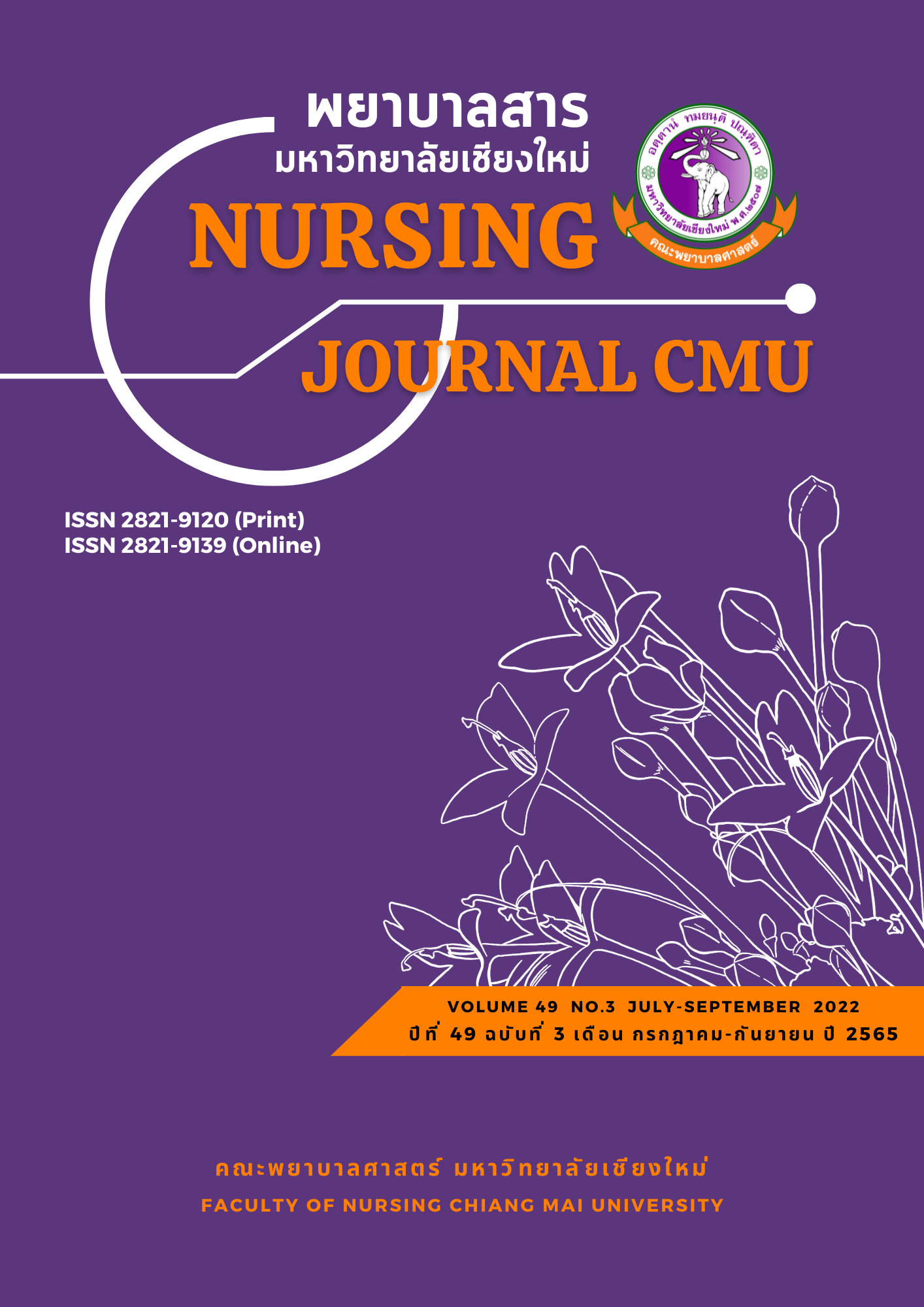Factors Related to Caring of Pediatric Nurses in Tertiary Hospitals
Keywords:
Caring, Sick children and caregivers, NursesAbstract
Caring by pediatric nurses involves cooperation among nurses, pediatric patients, and families of pediatric patients receiving holistic care. The objective of this correlational descriptive research study was to examine caring of pediatric nurses and the relationship of emotional stability and organizational climate to caring of pediatric nurses. Watson’s concept of caring (1988) and a literature review were used as the conceptual framework in this study. The samples, selected by purposive sampling, comprised 98 registered nurses in pediatric wards of two tertiary hospitals in northern Thailand. The research instruments included the Emotional Stability Questionnaire, the Organizational Climate Questionnaire, and the Caring Behavior of Pediatric Nurses Questionnaire. Data were analyzed using descriptive statistics and Spearman’s rank correlation coefficient.
The results were as follows:
- The total mean scores of caring of pediatric nurses were at a high level (= 102.36, SD = 12.09). In terms of each individual dimension, it was found that the mean scores of 9 out of 10 dimensions were at a high level with the highest being the 8th dimension: provision for a supportive, protective, and corrective mental, physical, sociocultural, and spiritual environment (= 17.41, SD = 2.37). Mean scores in the tenth dimension, allowance for existential-phenomenological forces, were at a moderate level (= 1.91, SD = 0.70).
- Emotional stability showed a statistically significant positive correlation at a high level with the caring of pediatric nurses (rs = .694, p < .05). Organizational climate had a statistically significant positive correlation at a high level with the caring of pediatric nurses (rs = .673, p < .05).
The results of this study provide preliminary information about factors related to caring of pediatric nurses. Emotional stability and a positive organizational climate should be promoted among pediatric nurses to increase caring in holistically serving the needs of pediatric patients and families.
References
Anatun, A., Ting, T., Chieh, Y. L., Shu, F. V., & Mary, E. M. (2018). Caring behavior perceived by nurses, patients and nursing students in Indonesia. Journal of Professional Nursing,34(2), 314-319.
Bitsani, E. (2013). Theoretical approaches to the organizational culture and the organizationalclimate: Exploratory research examples and best policies in health care services.Journal of Human Resource Management, 1(4), 48-58.
Brunton, B., & Beaman. (2000). Nurse practitioners’ perceptions of their caring behavior. Journal of the American Academy of Nurse practitioners, 12, 451-456.
Burns, N., & Grove, S. K. (2009). The practice of nursing research: Appraisal, synthesis, and Generation of evidence (6th ed.). St. Louis, MO: Saunders Elsevier.
Coyne. (2006). Children’s experiences of hospital. Journal of child Health Care, 10(4), 326-336.
Danphathong, A. (2009). Caring behaviors of end of life patients as per the perception ofnurses. Journal of Nursing Division, 36(1), 15-26. (in Thai)
Hockenberry, M. J., & Wilson, D. (2009). Wong’s essentials of pediatric nursing (8thed.). St. Louis, MO: Mosby/Elsevier.
Hughes, L. (2009). Peer group caring interaction scale and organizational climate forquestionnaire. In J. Watson (Ed.). Assessing and measuring caring in nursing and health sciences (2nd ed., pp. 149-162). New York: Springer.
Kaewvichien, S., & Sangkhamal. S. (2016), The development of nursing system for pediatric patients undergoing an open heart surgery at Queen Sirikit National Institute of Child Health. Research Thai Journal of Cardio-Thoracic Nursing, 27(1), 56-71. (in Thai)
Klunklin, P. (2017). Pediatric nursing for health promotion. Chiang Mai: Smart Coating. (in Thai)
Kongbunyapong, B., & Pinchaleaw, D. (2016). Factors Influencing Happiness in work place of professional nurses, community hospital, Surat Thani Province. Journal of The Police Nurse, 8(2), 151-160. (in Thai)
Litwin, G. H., & Stringer, R. A. (1968). Motivation and organization climate. Boston: Graduate School of Business Administration.
Lueluang, W., & Vorahan, W. (2011). Factors influencing role practices of professional nurses at operating room in regional hospitals, northeast region. (Master’s thesis of Nursing Science in Adult Nursing). Chiang Mai University. (in Thai)
Manojlovich, M. (2005). Professional nursing practice in hospital settings. Nursing Research, 54, 41-47.
Medical Records Unit. (2017). Statistical report. Chiang Mai: Medical Statistics Unit Maharaj Nakorn Chiang Mai Hospital.
Ormel, J., Bastiaansen, A., Riese, H., Bos, E. H., Servaas, M., Ellenbogen, M., & Aleman, A.(2013). The biological and psychological basis of neuroticism: Current status and futuredirections. Research Neuroscience and Biobehavioral, 37(1), 59-72.
Polit, D. F. (2010). Statistics and data analysis for nursing. research (2nd ed.). New Jersey:Pearson.
Raksamanee, A. (2007). Relationship between job characteristics. ethical intelligence with the ability of operating room nurses State University Hospital. Chulalongkorn University: Bangkok. Retrieved from https://doi.nrct.go.th/ListDoi/listDetail?Resolve_
Rerksadayut, P. (2013). Caring behaviors of perioperative nurses and related factors as perceived by perioperative. (Master’s thesis of Nursing Science in Adult Nursing). Prince of Songkla University. (in Thai)
Roach, M. S. (2002). Caring: The human mode of being (2nd ed.). Ottawa: CHA Press.
Ronald, J. B., Matthiesen, S. B., & Pallesen, S. (2005). Personality and individual differences.
Research Personality and Individual Differences 40, 1223–1233. Skulpunyawat, S. (2014). Supervision by the caring behavior. Journal of The Police Nurse, 6(2), 200-208.
Srisathitnarakun, B. (2007). The methodology in nursing research. Bangkok: U & I International Media. (in Thai)
Teng, C. I., Chang, S. S., & Hsu, K. H. (2009). Emotional stability of nurses: Impact on patient safety. Journal of Advanced Nursing, 65, 2088-2096.
Watson, J. (1988). Nursing the philosophy and science of caring. Colorado: Colorado Associated University press.
Wolf, Z. R., Giardino, E. R., & Osborne, M. S. (1994). Dimension of nurse caring. Image–the Journal of Nursing Scholarship, 26(2), 107-111.
Wongcheeree, T. (2011). Factors influencing parent participation in the care of hospitalized children. The Journal of Faculty of Nursing Burapha University, 19(3), 23-36. (in Thai)
Downloads
Published
How to Cite
Issue
Section
License
Copyright (c) 2022 Nursing Journal

This work is licensed under a Creative Commons Attribution-NonCommercial-NoDerivatives 4.0 International License.
บทความที่ได้รับการตีพิมพ์เป็นลิขสิทธิ์ของวารสารพยาบาลสาร
ข้อความที่ปรากฏในบทความแต่ละเรื่องในวารสารวิชาการเล่มนี้เป็นความคิดเห็นส่วนตัวของผู้เขียนแต่ละท่านไม่เกี่ยวข้องกับมหาวิทยาลัยเชียงใหม่ และคณาจารย์ท่านอื่นๆในมหาวิทยาลัยฯ แต่อย่างใด ความรับผิดชอบองค์ประกอบทั้งหมดของบทความแต่ละเรื่องเป็นของผู้เขียนแต่ละท่าน หากมีความผิดพลาดใด ๆ ผู้เขียนแต่ละท่านจะรับผิดชอบบทความของตนเองแต่ผู้เดียว






